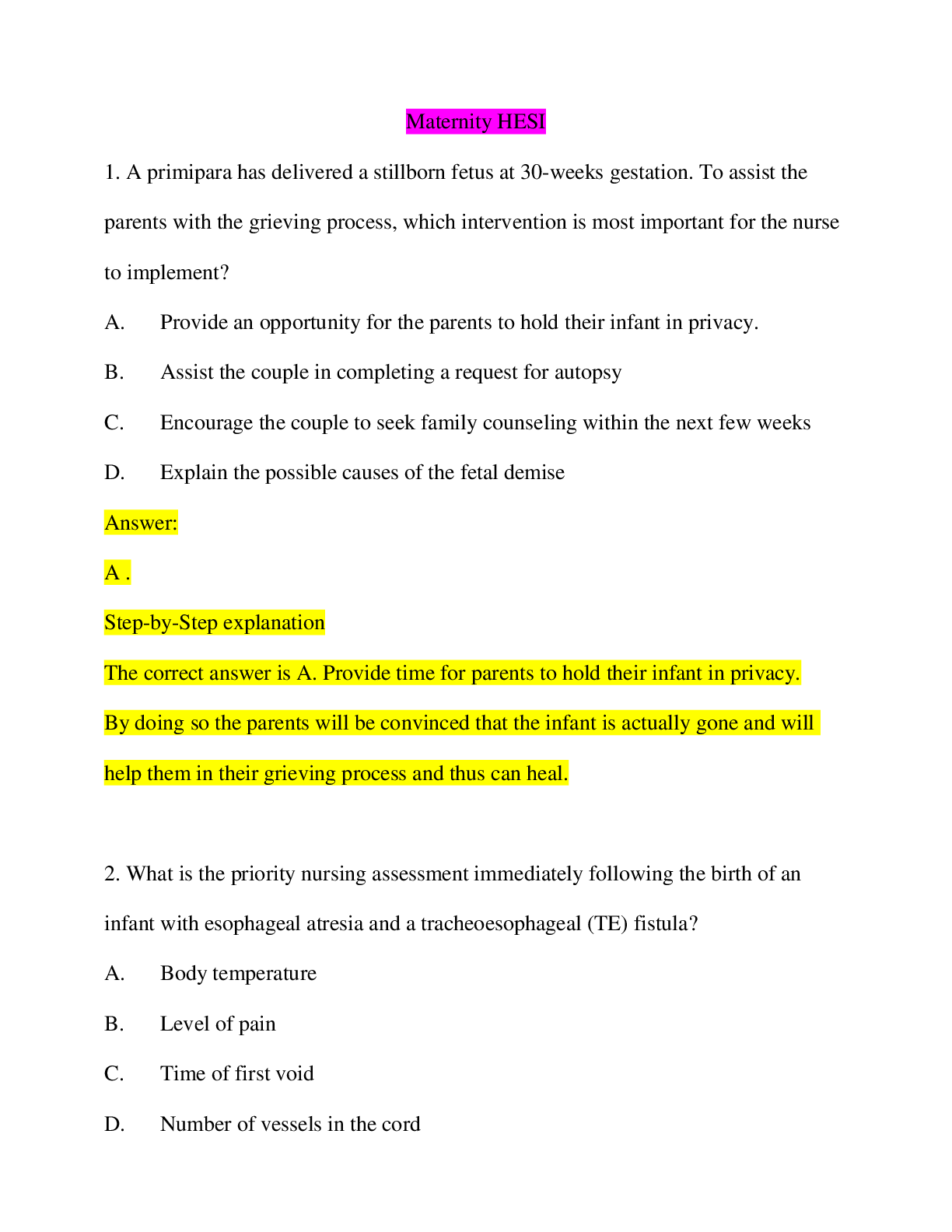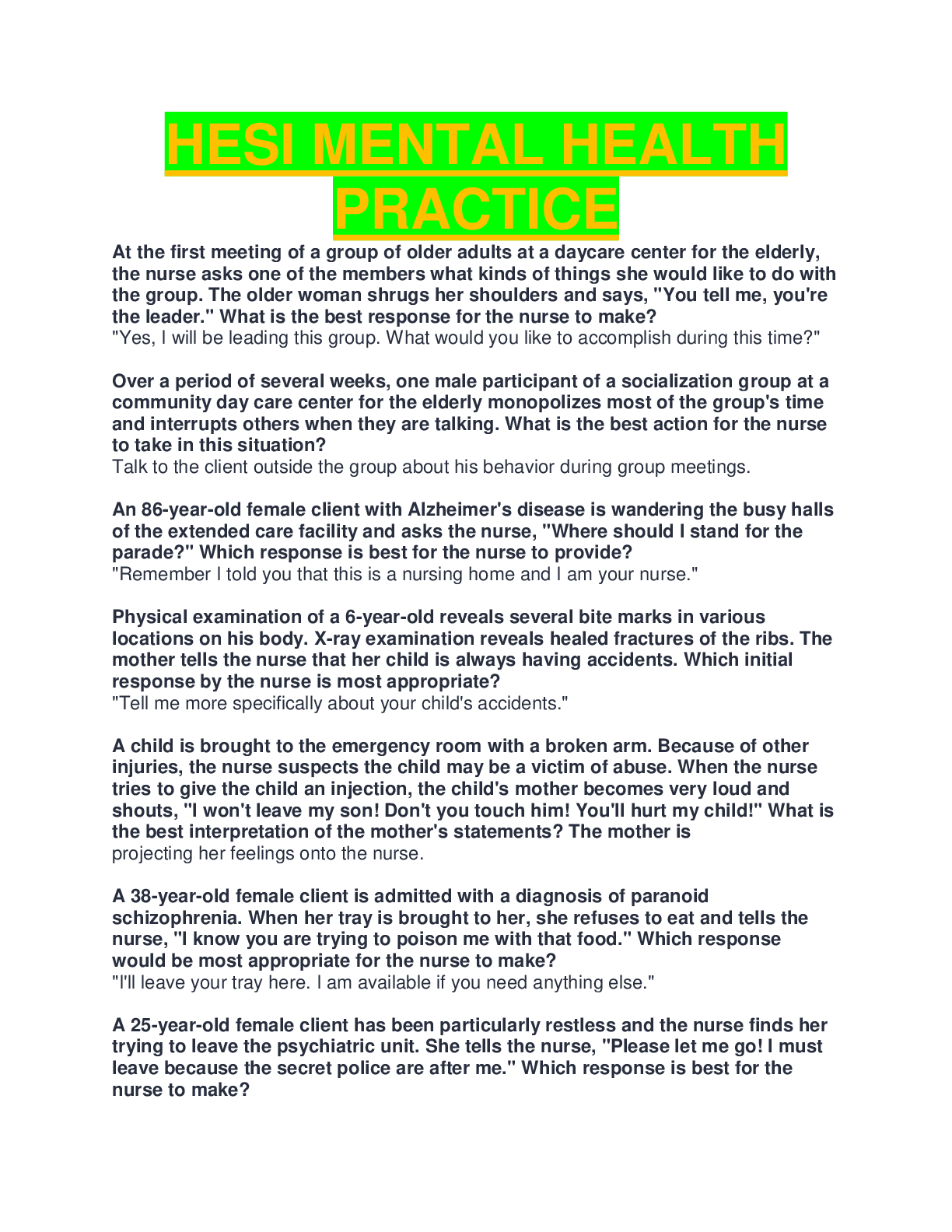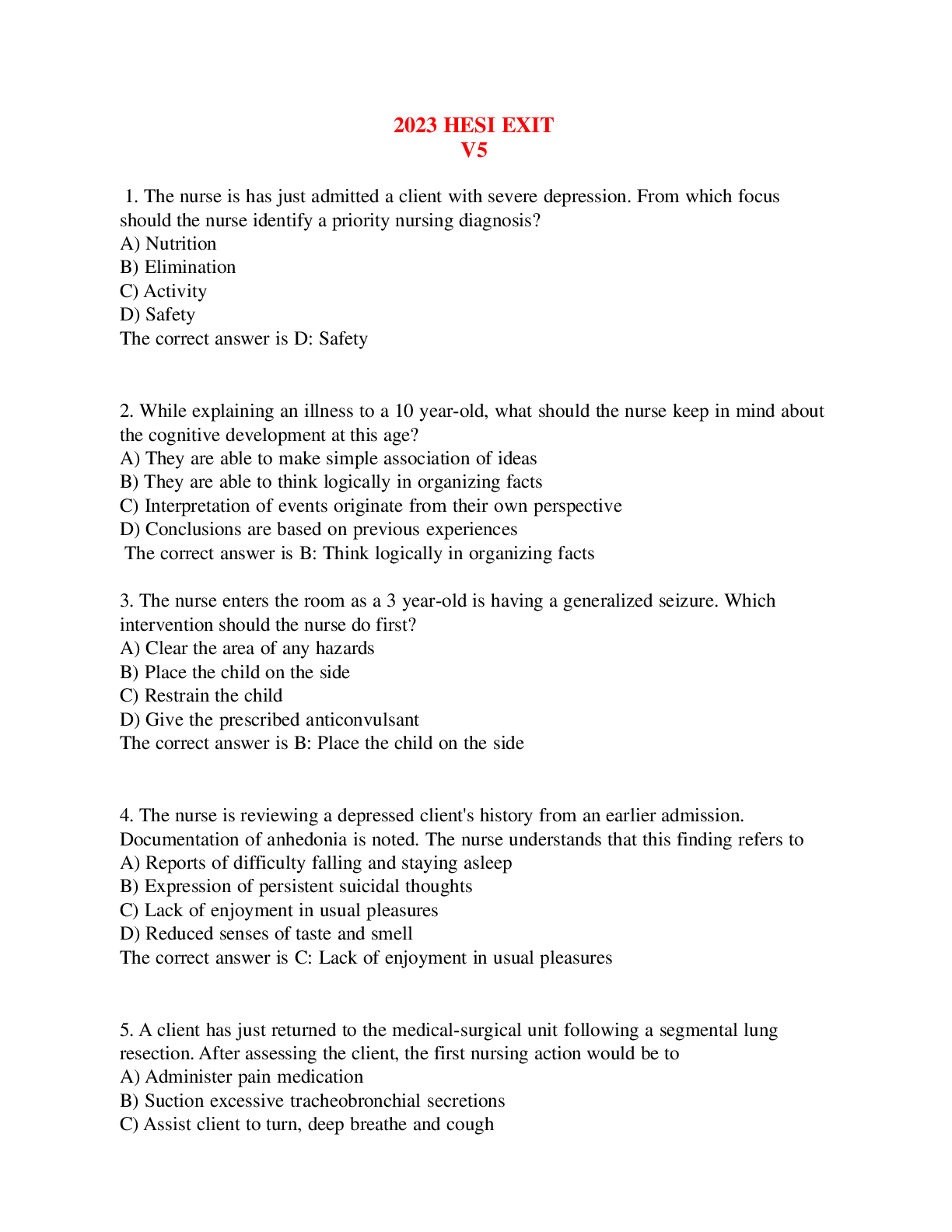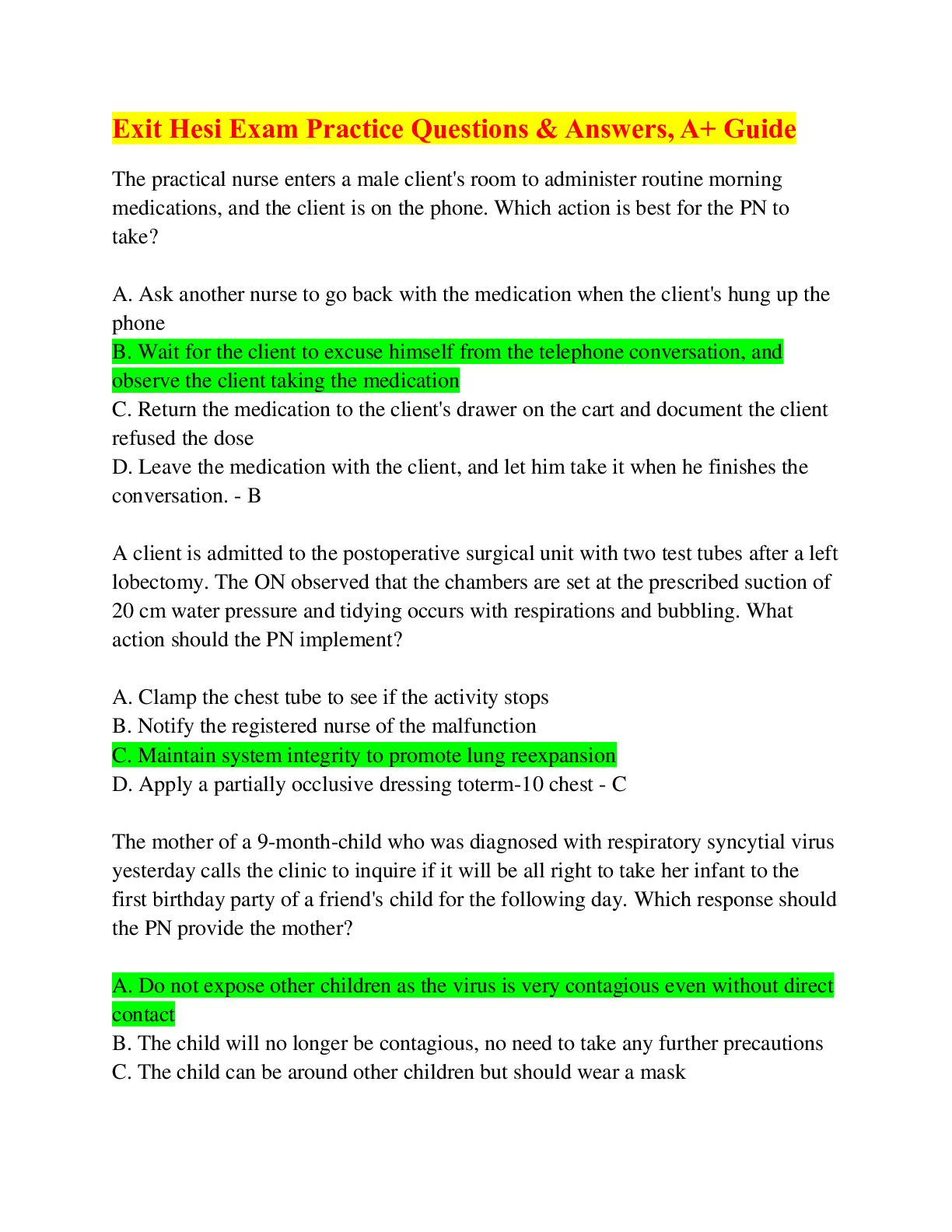Pharmacology > HESI > HESI Pharmacology Exam Practice questions with Rationale answers.245 questions Download to score A+ (All)
HESI Pharmacology Exam Practice questions with Rationale answers.245 questions Download to score A+
Document Content and Description Below
HESI Pharmacology Exam Practice questions with Rationaled answers.245 questions Download to score A+ 2.) Oral iron supplements are prescribed for a 6-year-old child with iron deficiency anemia. Th... e nurse instructs the mother to administer the iron with which best food item? 1. Milk 2. Water 3. Apple juice 4. Orange juice - 4. Orange juice Rationale: Vitamin C increases the absorption of iron by the body. The mother should be instructed to administer the medication with a citrus fruit or a juice that is high in vitamin C. Milk may affect absorption of the iron. Water will not assist in absorption. Orange juice contains a greater amount of vitamin C than apple juice. 3.) Salicylic acid is prescribed for a client with a diagnosis of psoriasis. The nurse monitors the client, knowing that which of the following would indicate the presence of systemic toxicity from this medication? 1. Tinnitus 2. Diarrhea 3. Constipation 4. Decreased respirations - 1. Tinnitus Rationale: Salicylic acid is absorbed readily through the skin, and systemic toxicity (salicylism) can result. Symptoms include tinnitus, dizziness, hyperpnea, and psychological disturbances. Constipation and diarrhea are not associated with salicylism.22.) A nurse is caring for a client after thyroidectomy and notes that calcium gluconate is prescribed for the client. The nurse determines that this medication has been prescribed to: 1. Treat thyroid storm. 2. Prevent cardiac irritability. 3. Treat hypocalcemic tetany. 4. Stimulate the release of parathyroid hormone. - 3. Treat hypocalcemic tetany. Rationale: Hypocalcemia can develop after thyroidectomy if the parathyroid glands are accidentally removed or injured during surgery. Manifestations develop 1 to 7 days after surgery. If the client develops numbness and tingling around the mouth, fingertips, or toes or muscle spasms or twitching, the health care provider is notified immediately. Calcium gluconate should be kept at the bedside. 23.) A client who has been newly diagnosed with diabetes mellitus has been stabilized with daily insulin injections. Which information should the nurse teach when carrying out plans for discharge? 1. Keep insulin vials refrigerated at all times. 2. Rotate the insulin injection sites systematically. 3. Increase the amount of insulin before unusual exercise. 4. Monitor the urine acetone level to determine the insulin dosage. - 2. Rotate the insulin injection sites systematically. Rationale: Insulin dosages should not be adjusted or increased before unusual exercise. If acetone is found in the urine, it may possibly indicate the need for additional insulin. To minimize the discomfort associated with insulin injections, the insulin should be administered at room temperature. Injection sites should be systematically rotated from one area to another. The client should be instructed to give injections in one area, about 1 inch apart, until the whole area has been used and then to change to another site. This prevents dramatic changes in daily insulin absorption. 24.) A nurse is reinforcing teaching for a client regarding how to mix regular insulin and NPH insulin in the same syringe. Which of the following actions, if performed by the client, indicates the need for further teaching? 1. Withdraws the NPH insulin first 2. Withdraws the regular insulin first3. Injects air into NPH insulin vial first 4. Injects an amount of air equal to the desired dose of insulin into the vial - 1. Withdraws the NPH insulin first Rationale: When preparing a mixture of regular insulin with another insulin preparation, the regular insulin is drawn into the syringe first. This sequence will avoid contaminating the vial of regular insulin with insulin of another type. Options 2, 3, and 4 identify the correct actions for preparing NPH and regular insulin. 25.) A home care nurse visits a client recently diagnosed with diabetes mellitus who is taking Humulin NPH insulin daily. The client asks the nurse how to store the unopened vials of insulin. The nurse tells the client to: 1. Freeze the insulin. 2. Refrigerate the insulin. 3. Store the insulin in a dark, dry place. 4. Keep the insulin at room temperature. - 2. Refrigerate the insulin. Rationale: Insulin in unopened vials should be stored under refrigeration until needed. Vials should not be frozen. When stored unopened under refrigeration, insulin can be used up to the expiration date on the vial. Options 1, 3, and 4 are incorrect. 27.) Sildenafil (Viagra) is prescribed to treat a client with erectile dysfunction. A nurse reviews the client's medical record and would question the prescription if which of the following is noted in the client's history? 1. Neuralgia 2. Insomnia 3. Use of nitroglycerin 4. Use of multivitamins - 3. Use of nitroglycerin Rationale: Sildenafil (Viagra) enhances the vasodilating effect of nitric oxide in the corpus cavernosum of the penis, thus sustaining an erection. Because of the effect of the medication, it is contraindicated with concurrent use of organic nitrates and nitroglycerin. Sildenafil is not contraindicated with the use of vitamins. Neuralgia and insomnia are side effects of the medication.28.) The health care provider (HCP) prescribes exenatide (Byetta) for a client with type 1 diabetes mellitus who takes insulin. The nurse knows that which of the following is the appropriate intervention? 1. The medication is administered within 60 minutes before the morning and evening meal. 2. The medication is withheld and the HCP is called to question the prescription for the client. 3. The client is monitored for gastrointestinal side effects after administration of the medication. 4. The insulin is withdrawn from the Penlet into an insulin syringe to prepare for administration. - 2. The medication is withheld and the HCP is called to question the prescription for the client. Rationale: Exenatide (Byetta) is an incretin mimetic used for type 2 diabetes mellitus only. It is not recommended for clients taking insulin. Hence, the nurse should hold the medication and question the HCP regarding this prescription. Although options 1 and 3 are correct statements about the medication, in this situation the medication should not be administered. The medication is packaged in prefilled pens ready for injection without the need for drawing it up into another syringe. 29.) A client is taking Humulin NPH insulin daily every morning. The nurse reinforces instructions for the client and tells the client that the most likely time for a hypoglycemic reaction to occur is: 1. 2 to 4 hours after administration 2. 4 to 12 hours after administration 3. 16 to 18 hours after administration 4. 18 to 24 hours after administration - 2. 4 to 12 hours after administration Rationale: Humulin NPH is an intermediate-acting insulin. The onset of action is 1.5 hours, it peaks in 4 to 12 hours, and its duration of action is 24 hours. Hypoglycemic reactions most likely occur during peak time. 30.) A client with diabetes mellitus visits a health care clinic. The client's diabetes mellitus previously had been well controlled with glyburide (DiaBeta) daily, but recently the fasting blood glucose level has been 180 to 200 mg/dL. Which medication, if added to the client's regimen, may have contributed to the hyperglycemia? 1. Prednisone 2. Phenelzine (Nardil) 3. Atenolol (Tenormin) 4. Allopurinol (Zyloprim) - 1. PrednisoneRationale: Prednisone may decrease the effect of oral hypoglycemics, insulin, diuretics, and potassium supplements. Option 2, a monoamine oxidase inhibitor, and option 3, a β-blocker, have their own intrinsic hypoglycemic activity. Option 4 decreases urinary excretion of sulfonylurea agents, causing increased levels of the oral agents, which can lead to hypoglycemia. 31.) A community health nurse visits a client at home. Prednisone 10 mg orally daily has been prescribed for the client and the nurse reinforces teaching for the client about the medication. Which statement, if made by the client, indicates that further teaching is necessary? 1. "I can take aspirin or my antihistamine if I need it." 2. "I need to take the medication every day at the same time." 3. "I need to avoid coffee, tea, cola, and chocolate in my diet." 4. "If I gain more than 5 pounds a week, I will call my doctor." - 1. "I can take aspirin or my antihistamine if I need it." Rationale: Aspirin and other over-the-counter medications should not be taken unless the client consults with the health care provider (HCP). The client needs to take the medication at the same time every day and should be instructed not to stop the medication. A slight weight gain as a result of an improved appetite is expected, but after the dosage is stabilized, a weight gain of 5 lb or more weekly should be reported to the HCP. Caffeine-containing foods and fluids need to be avoided because they may contribute to steroid-ulcer development. 40.) The client who chronically uses nonsteroidal anti-inflammatory drugs has been taking misoprostol (Cytotec). The nurse determines that the medication is having the intended therapeutic effect if which of the following is noted? 1. Resolved diarrhea 2. Relief of epigastric pain 3. Decreased platelet count 4. Decreased white blood cell count - 2. Relief of epigastric pain Rationale: The client who chronically uses nonsteroidal anti-inflammatory drugs (NSAIDs) is prone to gastric mucosal injury. Misoprostol is a gastric protectant and is given specifically to prevent this occurrence. Diarrhea can be a side effect of the medication, but is not an intended effect. Options 3 and 4 are incorrect.42.) A client with a peptic ulcer is diagnosed with a Helicobacter pylori infection. The nurse is reinforcing teaching for the client about the medications prescribed, including clarithromycin (Biaxin), esomeprazole (Nexium), and amoxicillin (Amoxil). Which statement by the client indicates the best understanding of the medication regimen? 1. "My ulcer will heal because these medications will kill the bacteria." 2. "These medications are only taken when I have pain from my ulcer." 3. "The medications will kill the bacteria and stop the acid production." 4. "These medications will coat the ulcer and decrease the acid production in my stomach." - 3. "The medications will kill the bacteria and stop the acid production." Rationale: Triple therapy for Helicobacter pylori infection usually includes two antibacterial drugs and a proton pump inhibitor. Clarithromycin and amoxicillin are antibacterials. Esomeprazole is a proton pump inhibitor. These medications will kill the bacteria and decrease acid production. 45.) A client has a prescription to take guaifenesin (Humibid) every 4 hours, as needed. The nurse determines that the client understands the most effective use of this medication if the client states that he or she will: 1. Watch for irritability as a side effect. 2. Take the tablet with a full glass of water. 3. Take an extra dose if the cough is accompanied by fever. 4. Crush the sustained-release tablet if immediate relief is needed. - 2. Take the tablet with a full glass of water. Rationale: Guaifenesin is an expectorant. It should be taken with a full glass of water to decrease viscosity of secretions. Sustained-release preparations should not be broken open, crushed, or chewed. The medication may occasionally cause dizziness, headache, or drowsiness as side effects. The client should contact the health care provider if the cough lasts longer than 1 week or is accompanied by fever, rash, sore throat, or persistent headache. [Show More]
Last updated: 1 year ago
Preview 1 out of 26 pages
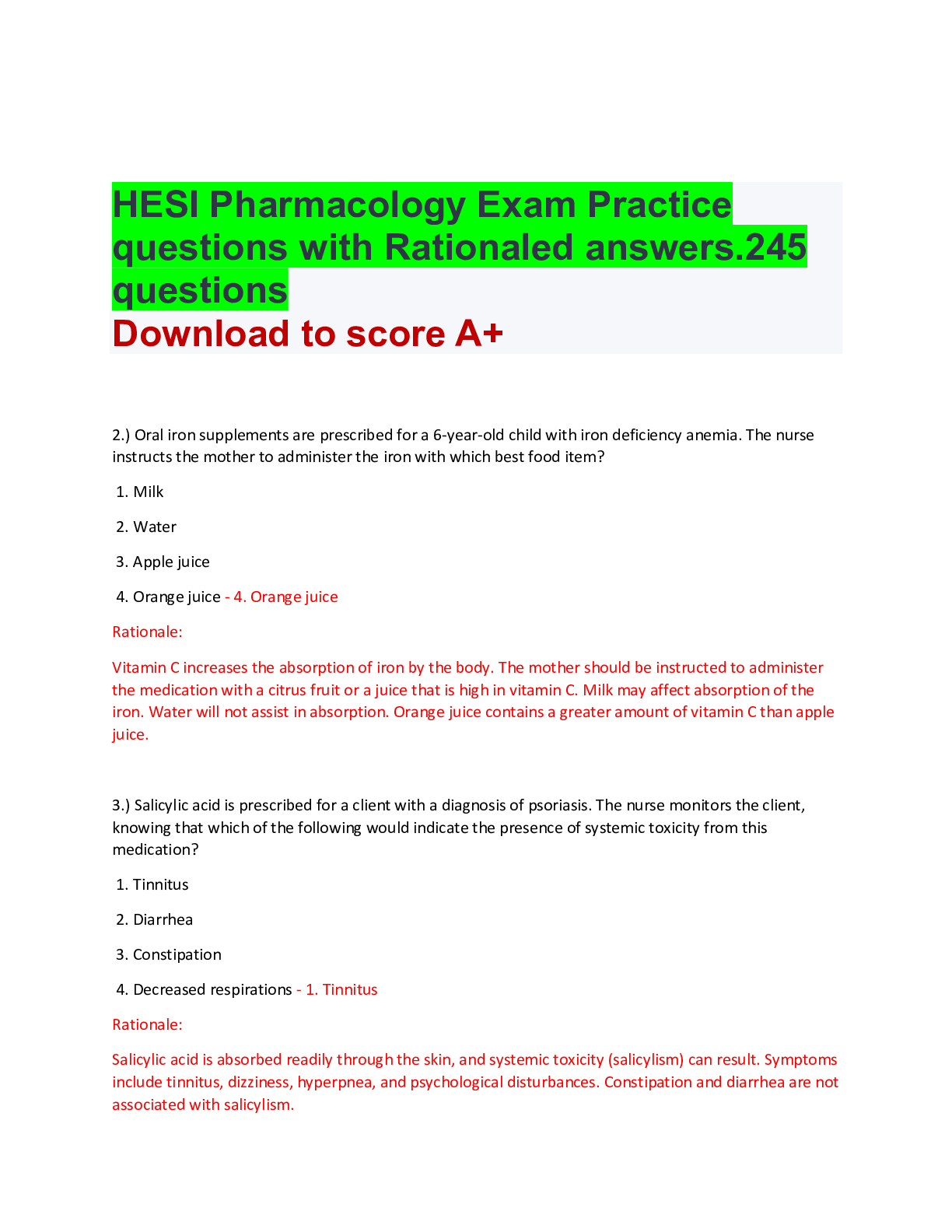
Reviews( 0 )
Document information
Connected school, study & course
About the document
Uploaded On
May 17, 2022
Number of pages
26
Written in
Additional information
This document has been written for:
Uploaded
May 17, 2022
Downloads
0
Views
98


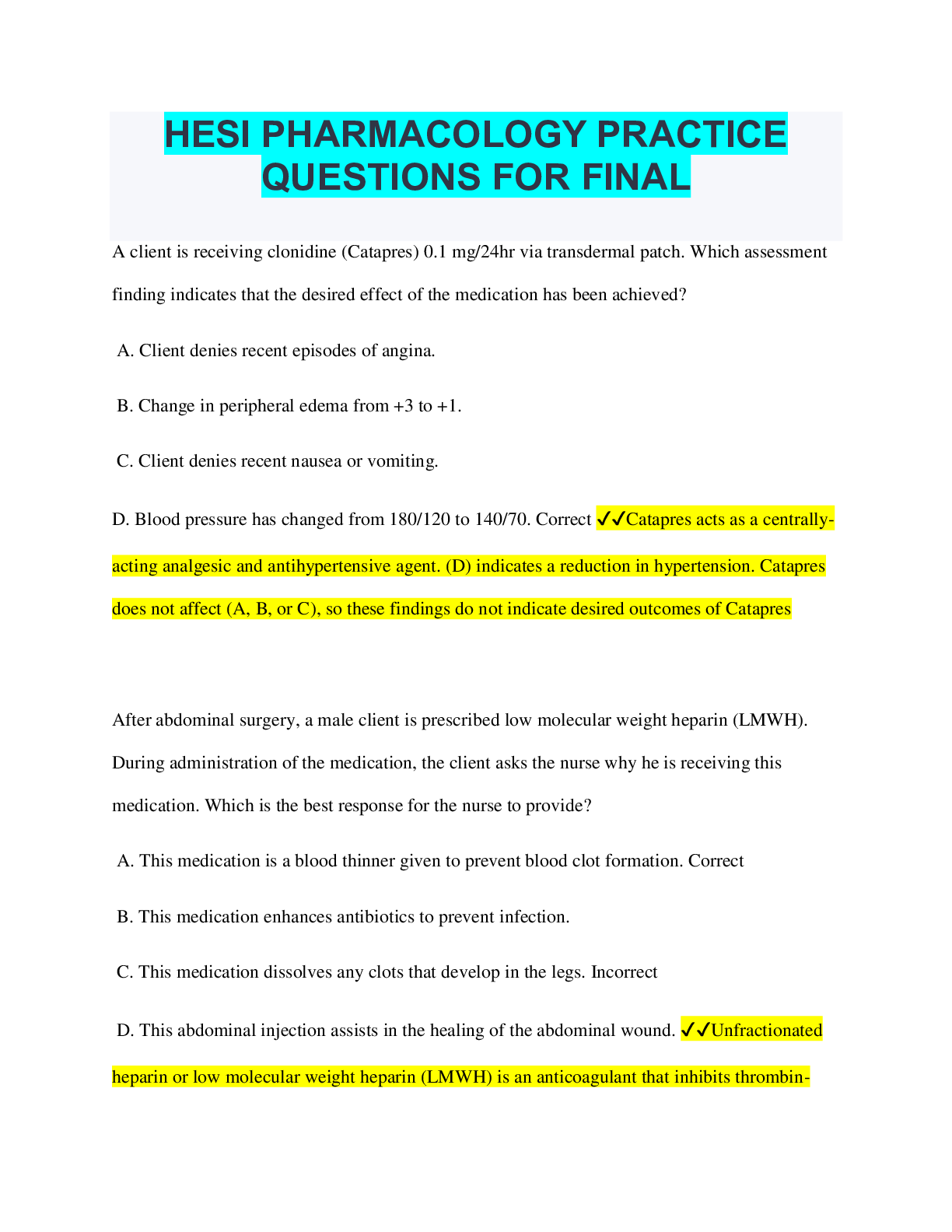
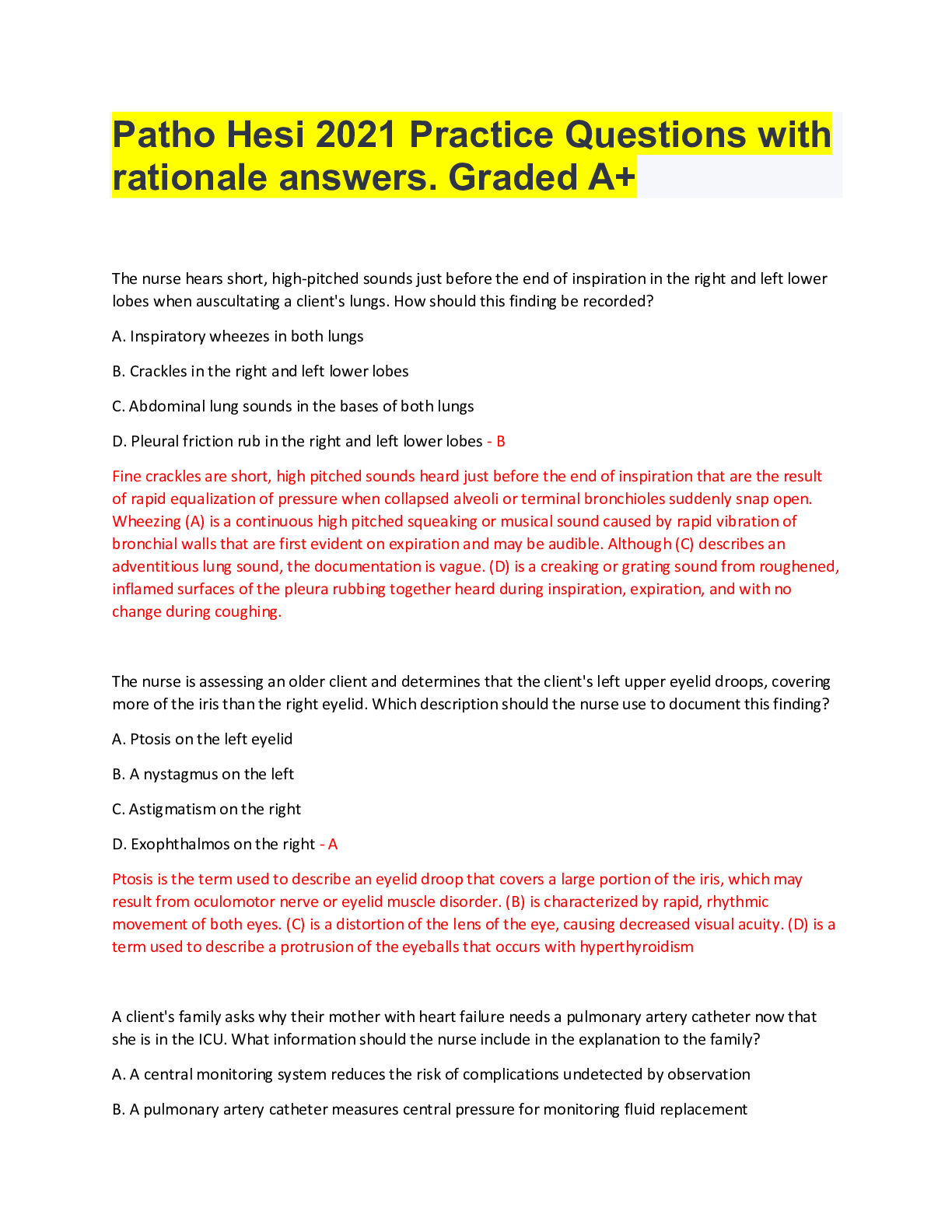
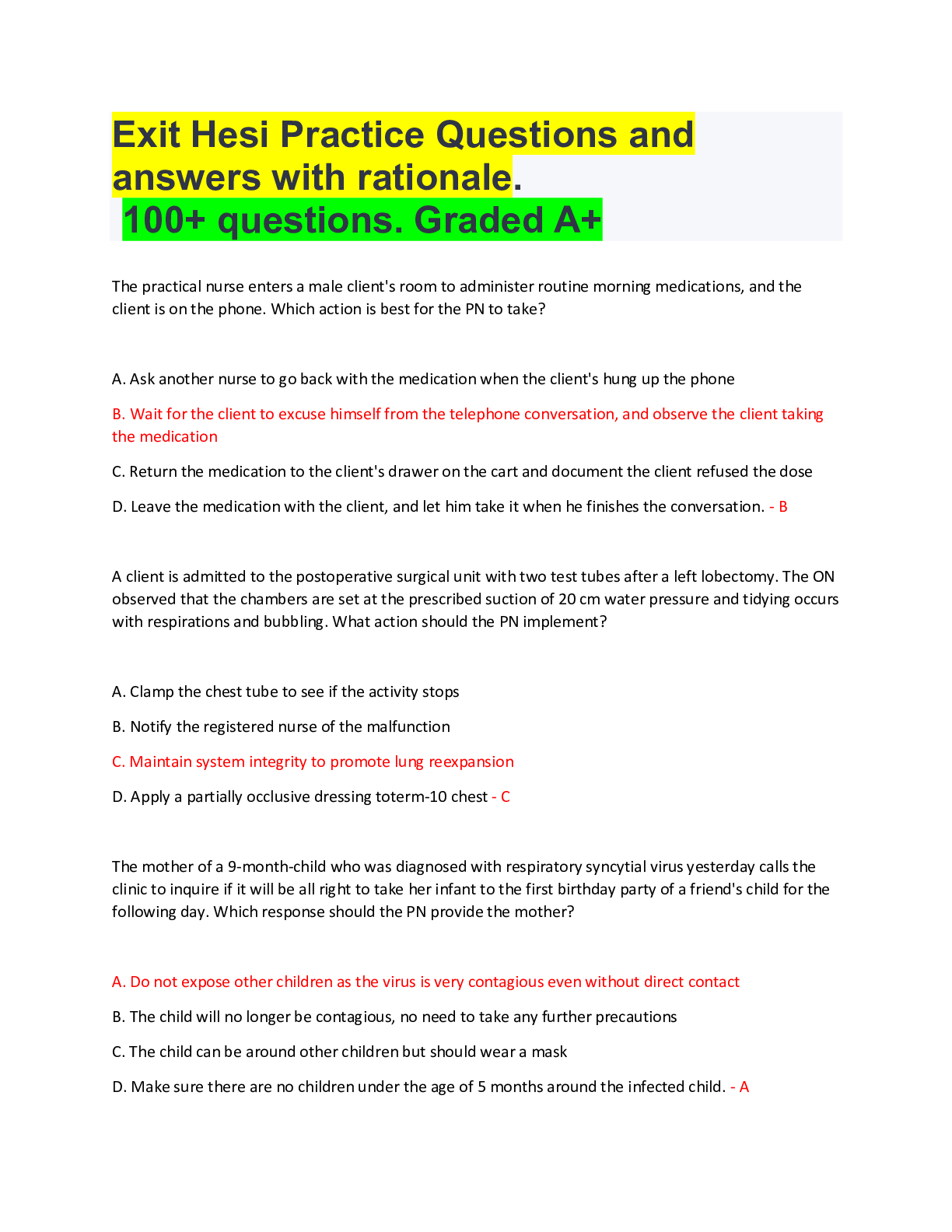
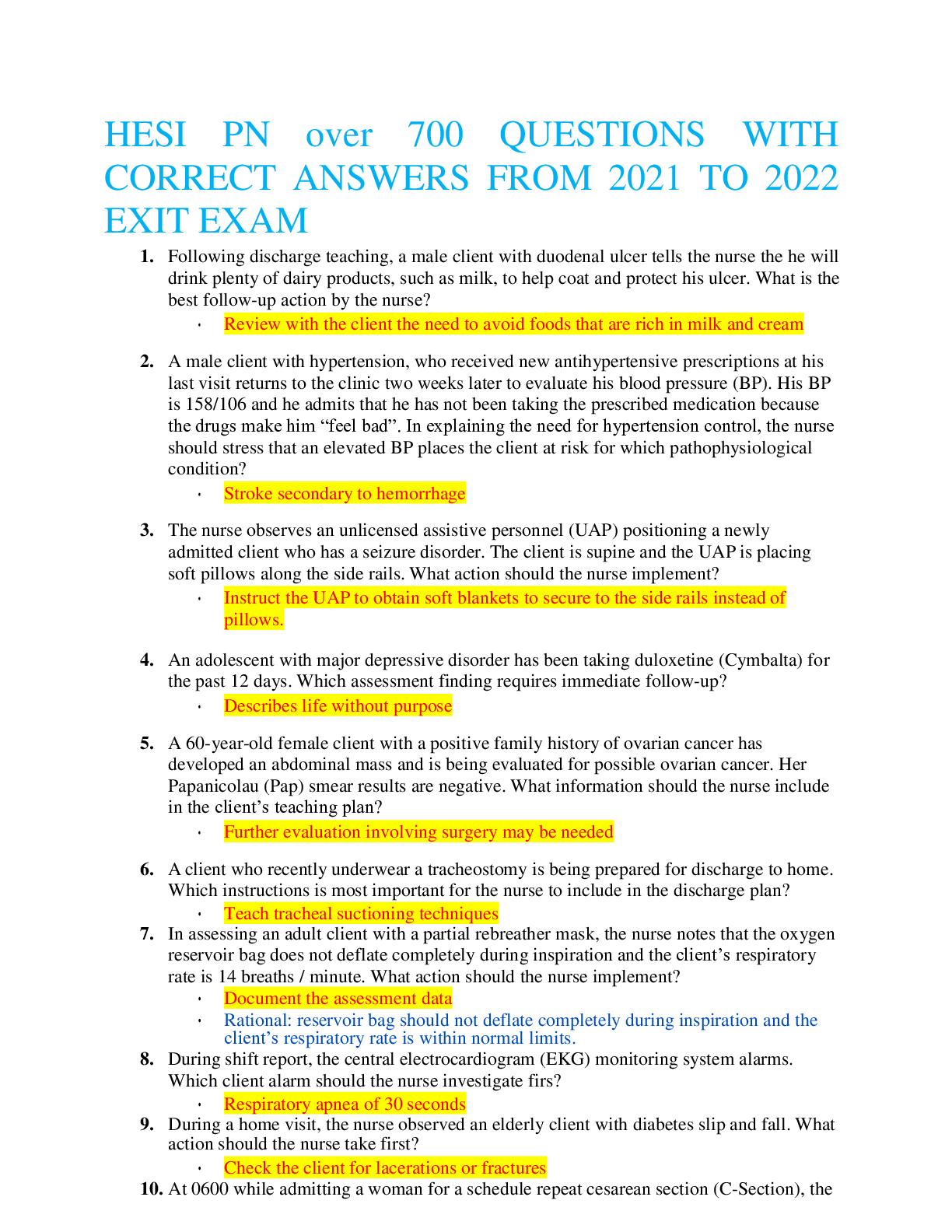
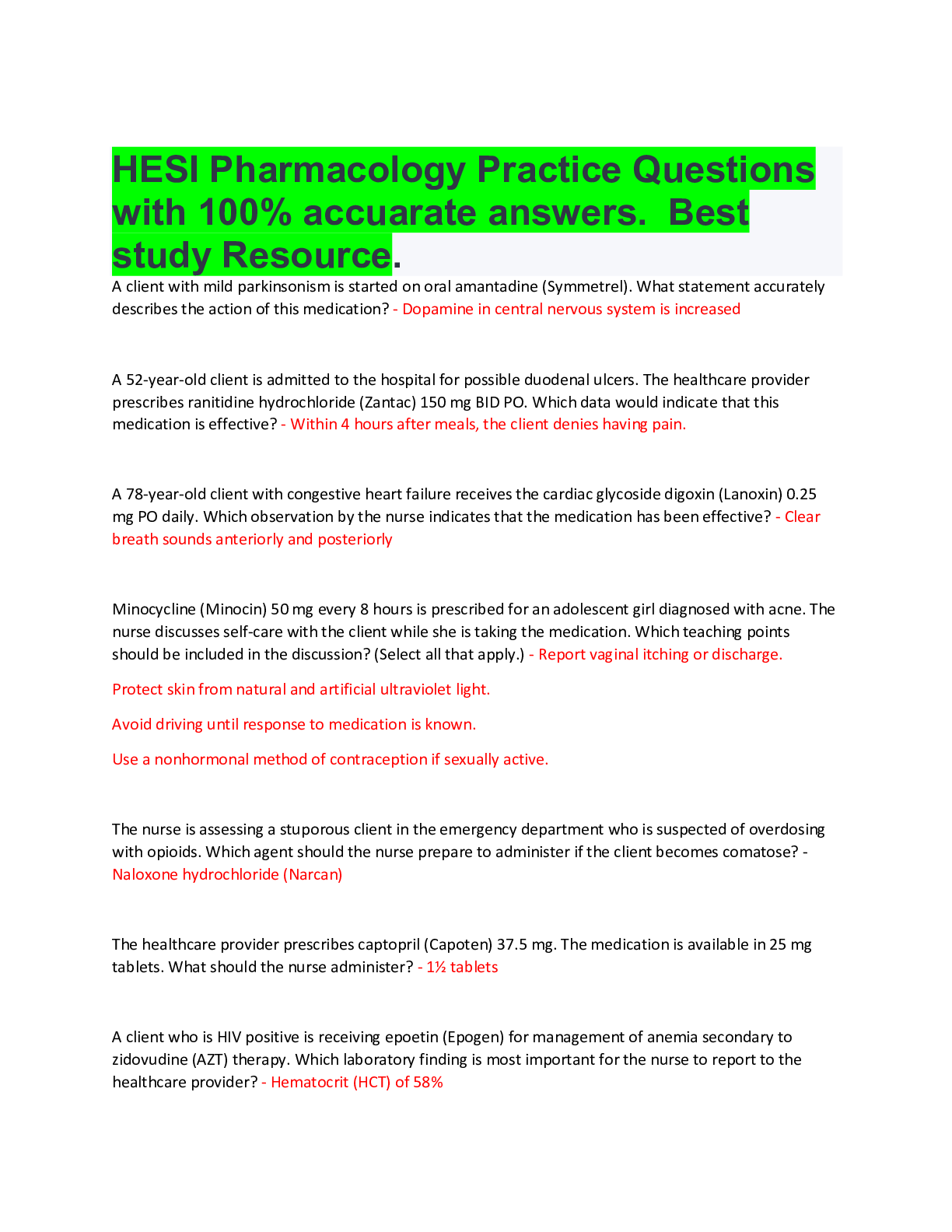

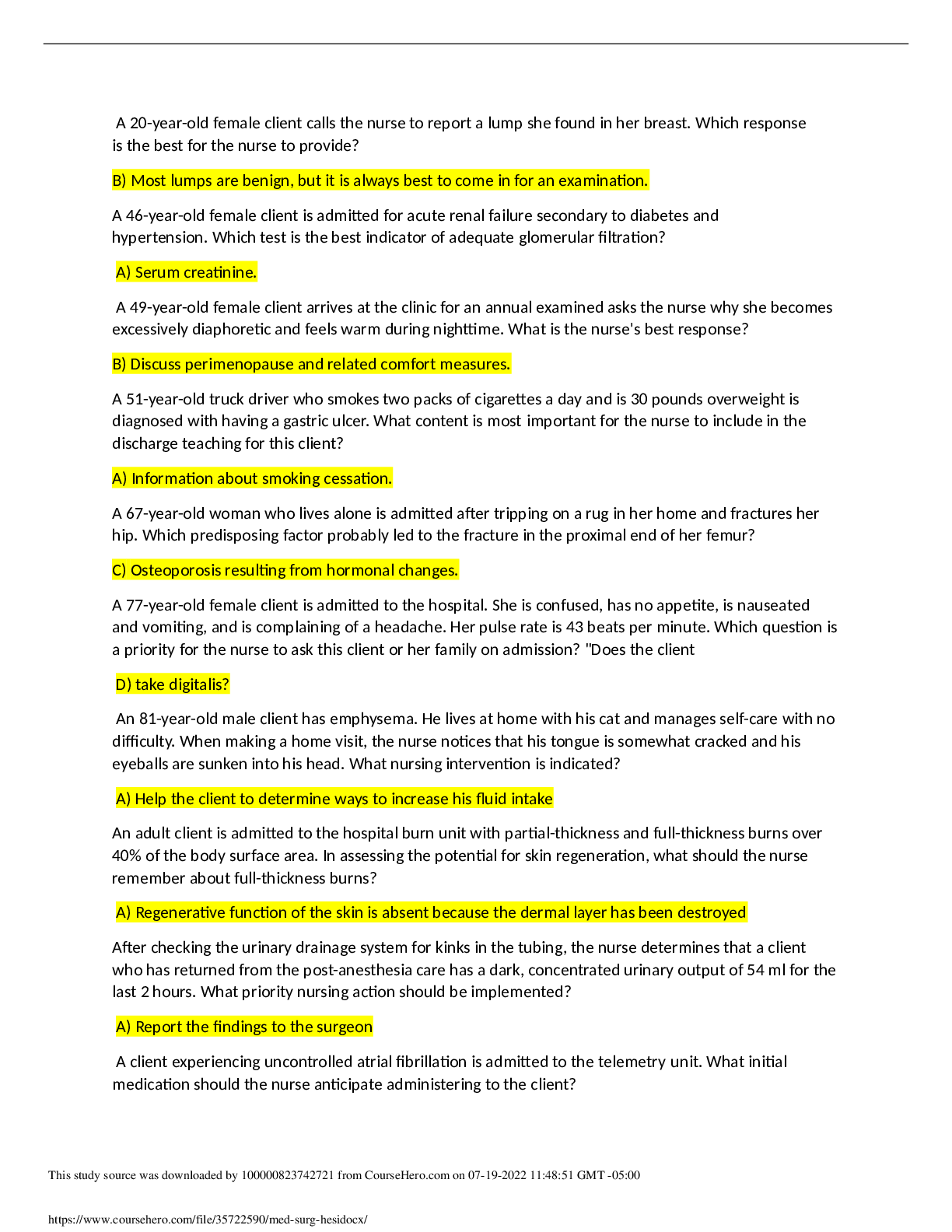
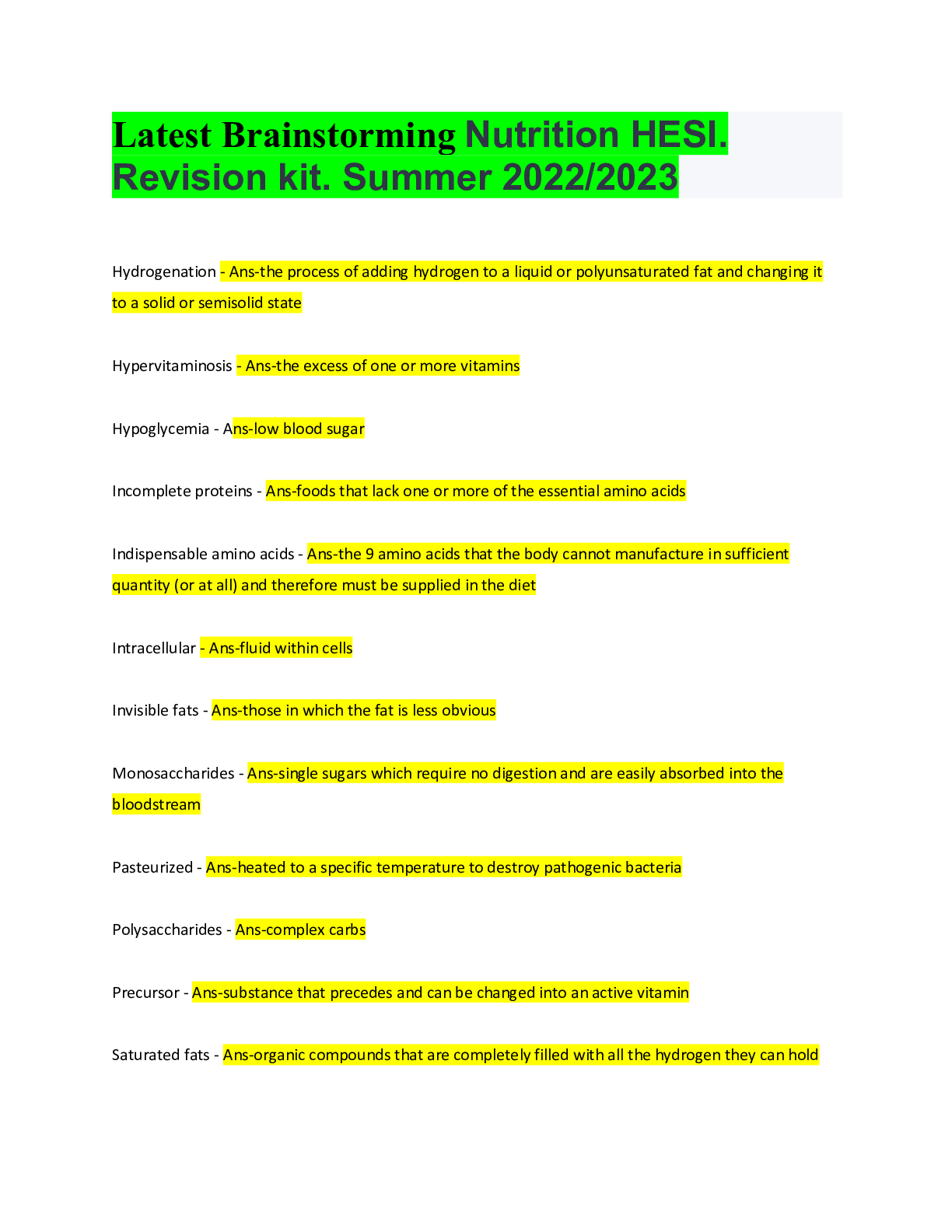
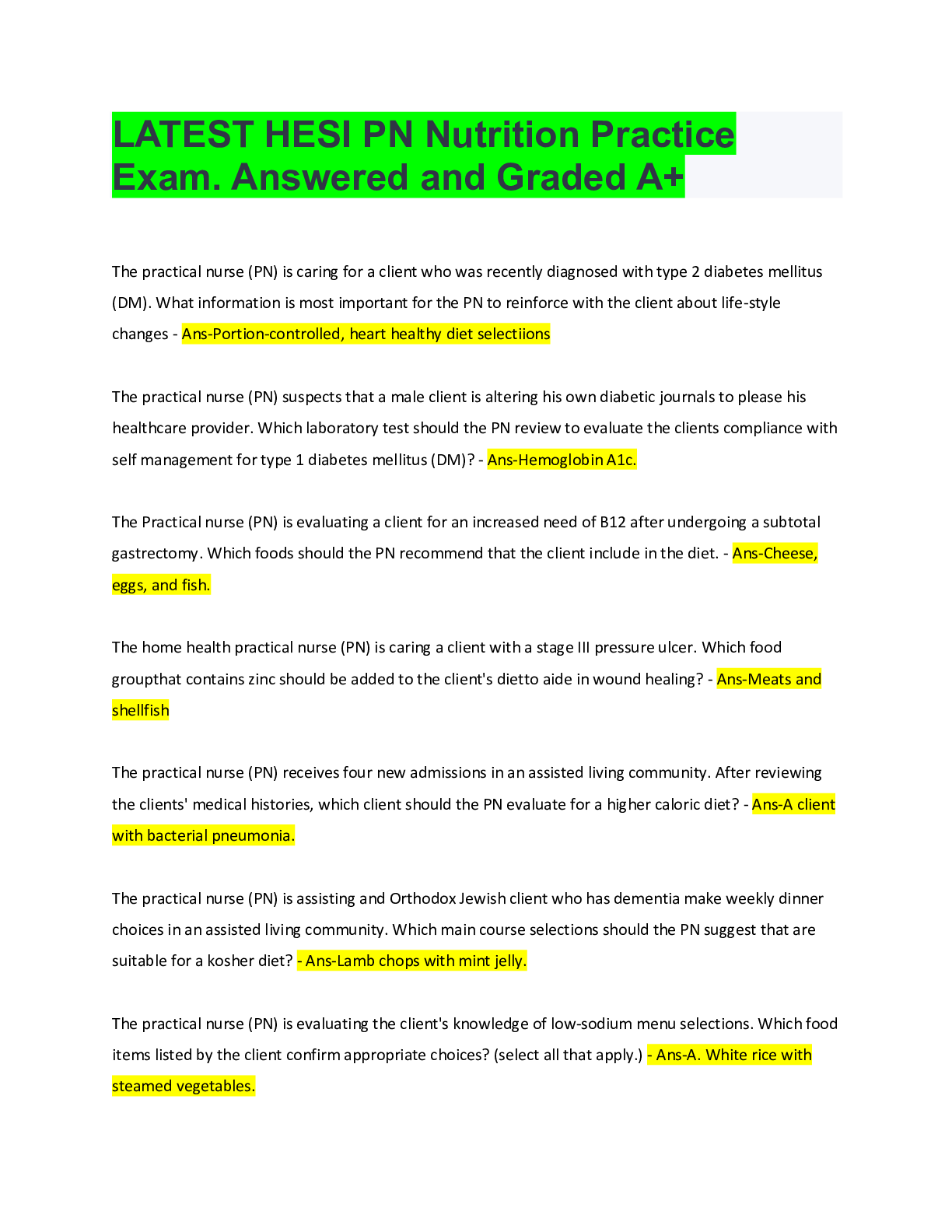
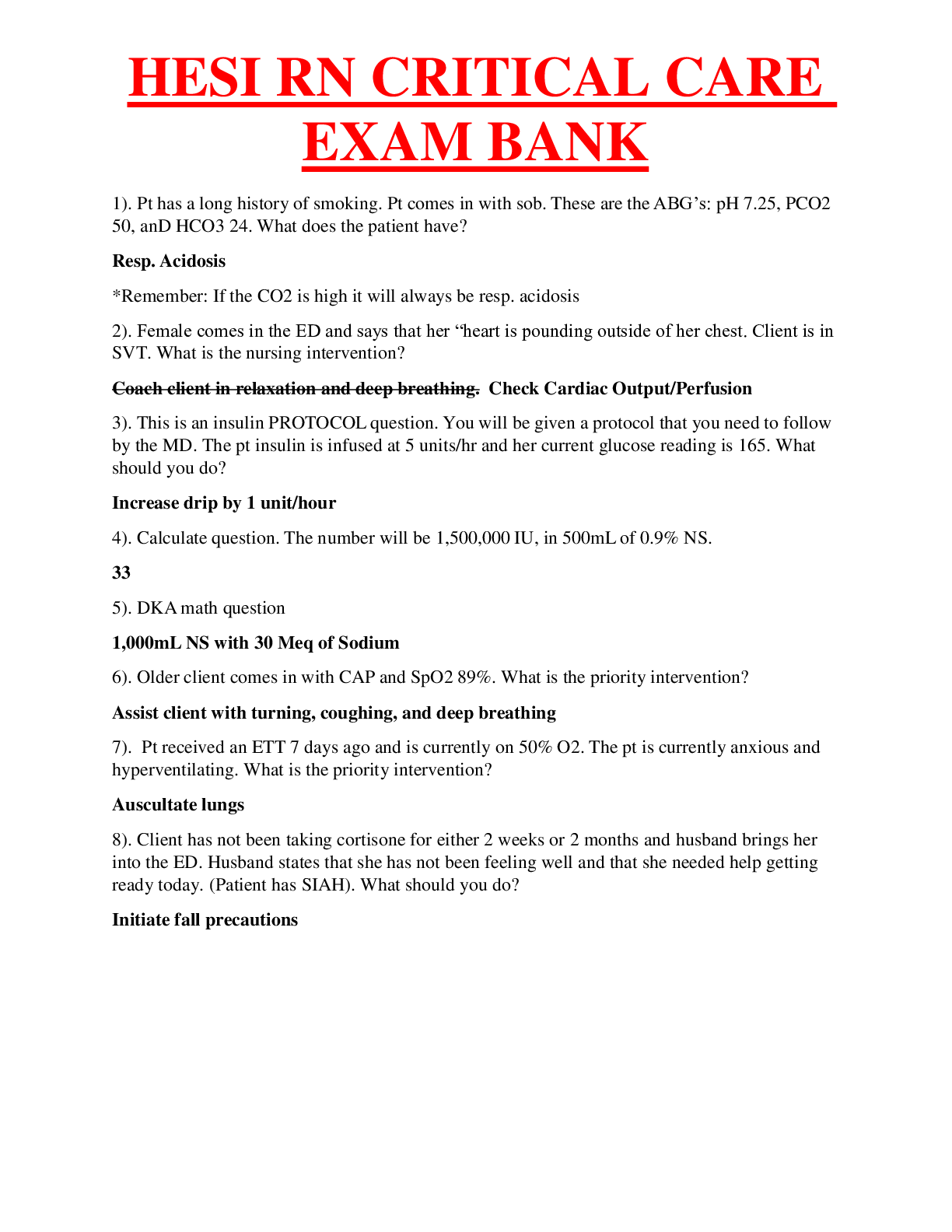

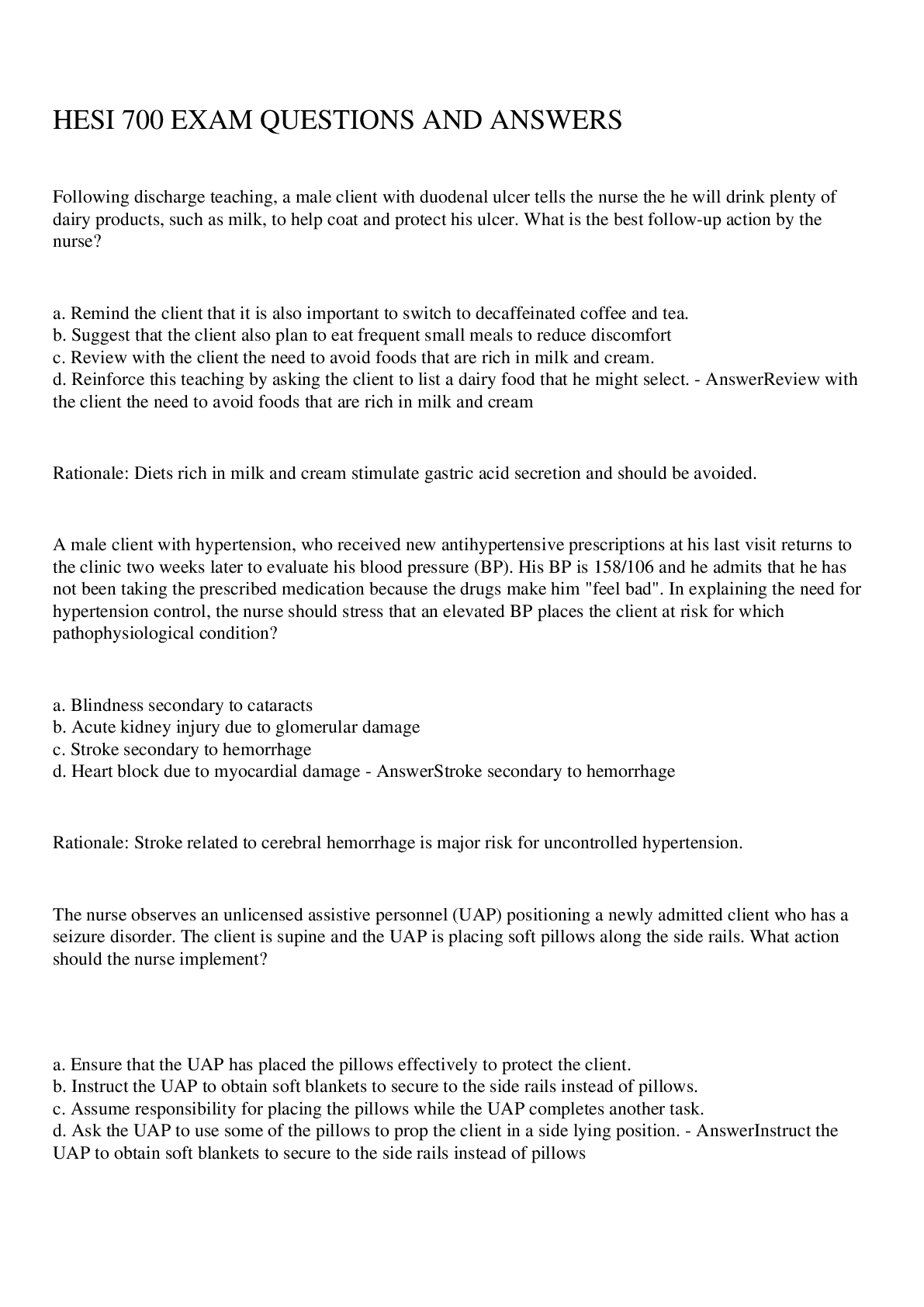
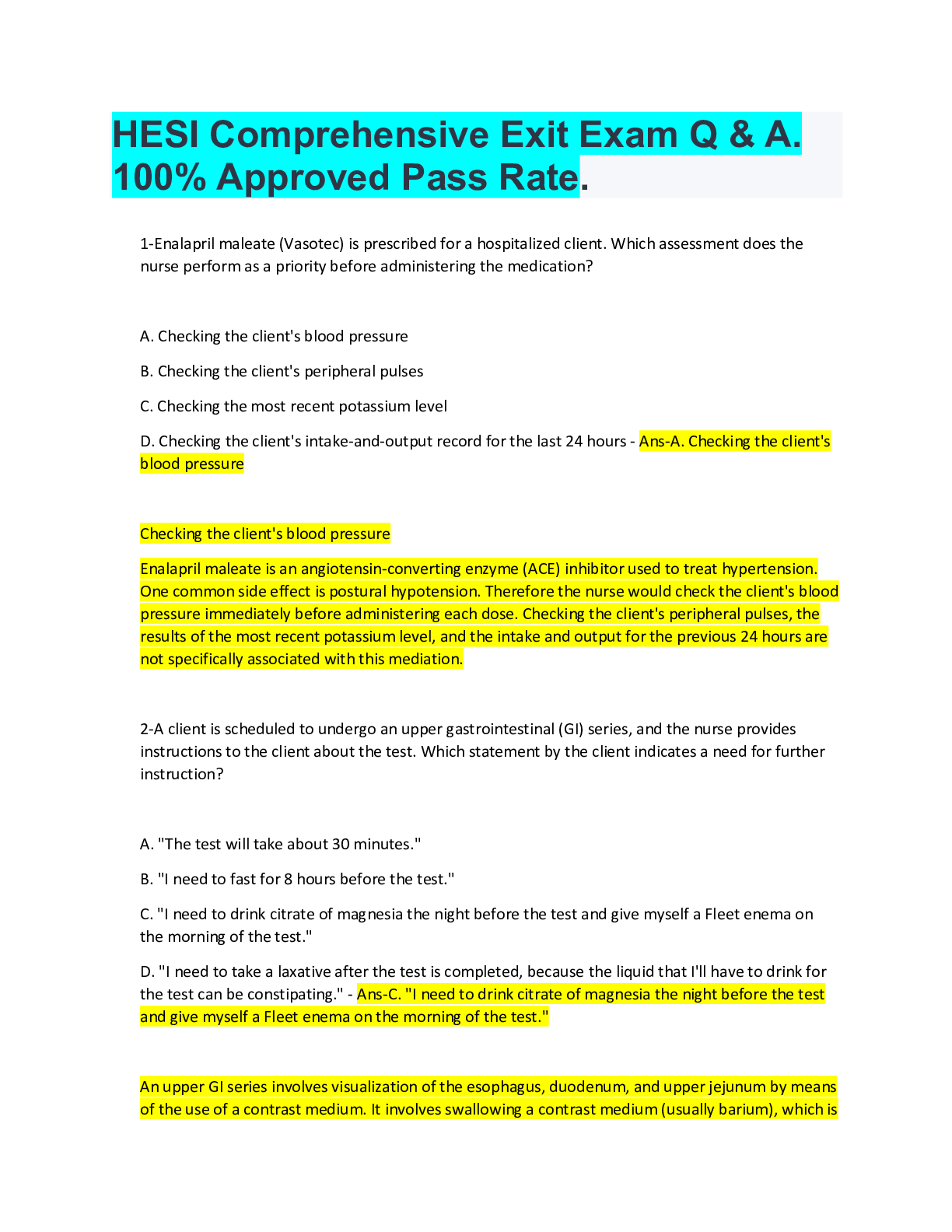
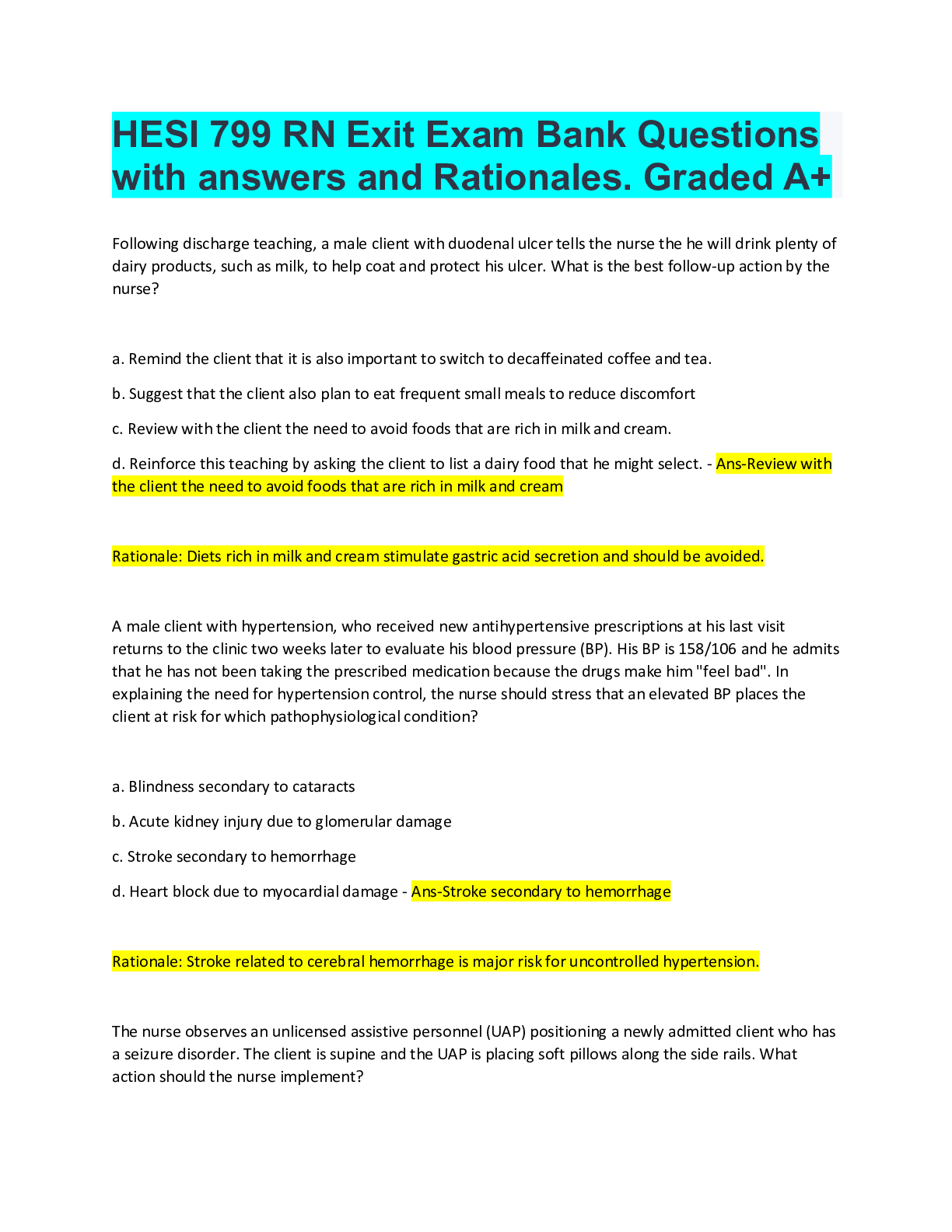
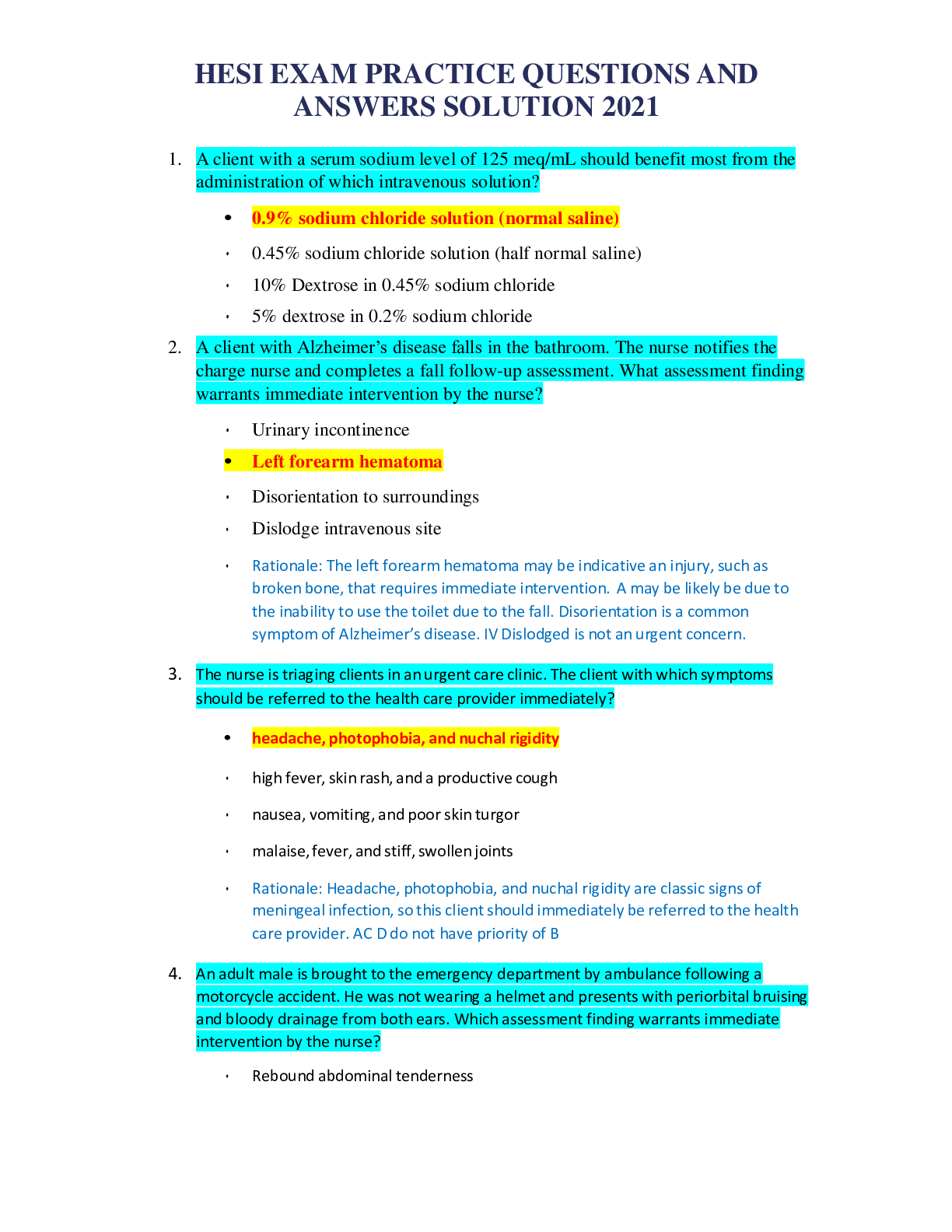
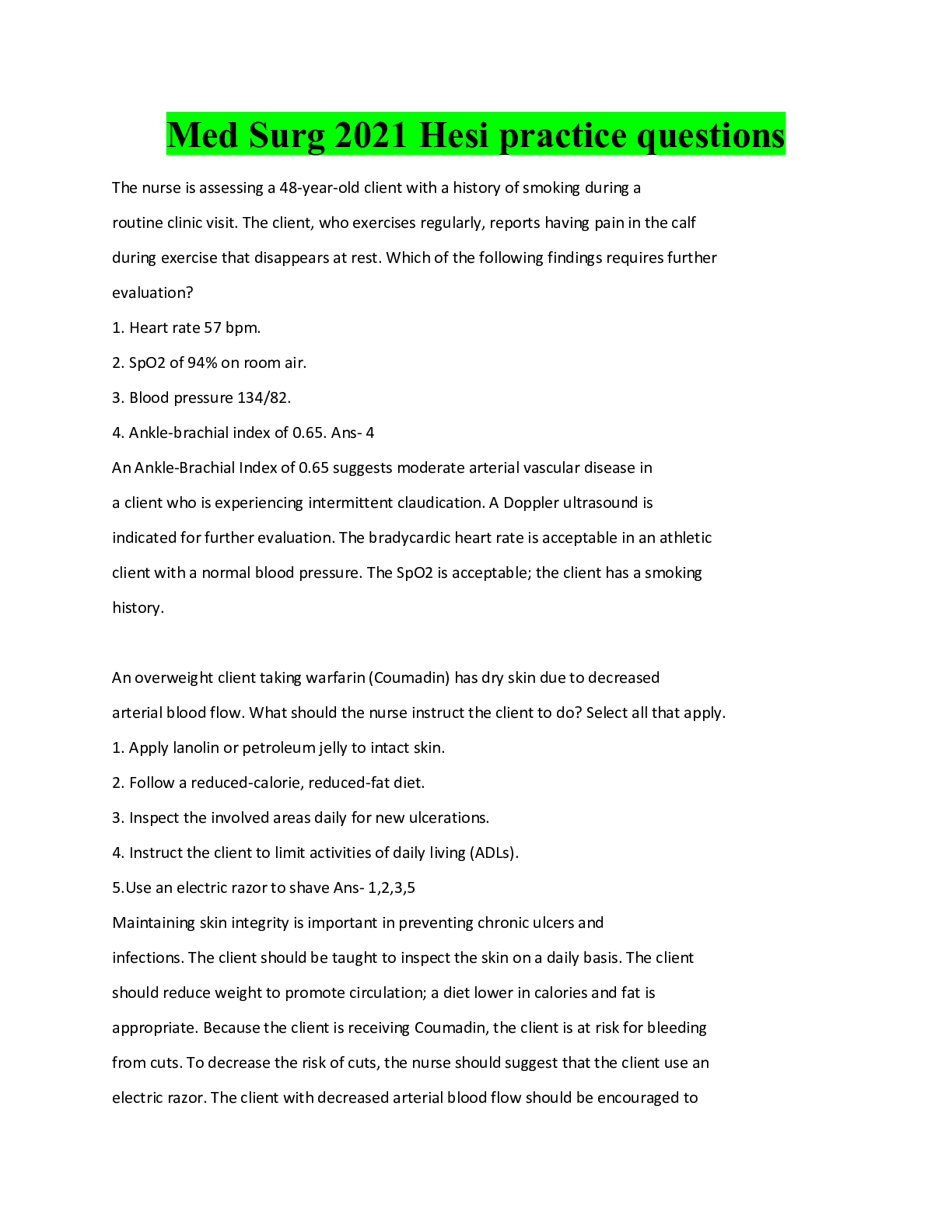
.png)
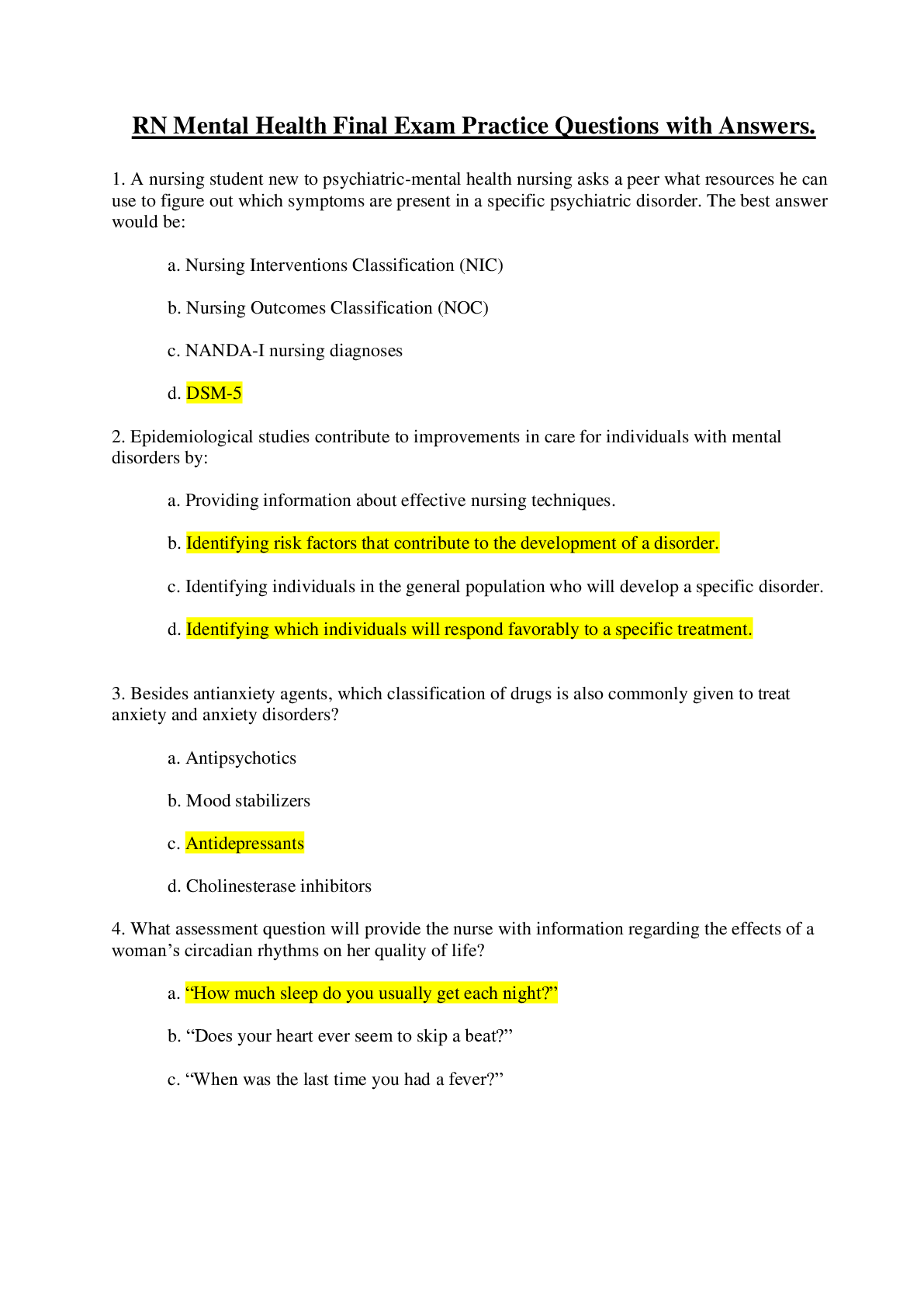
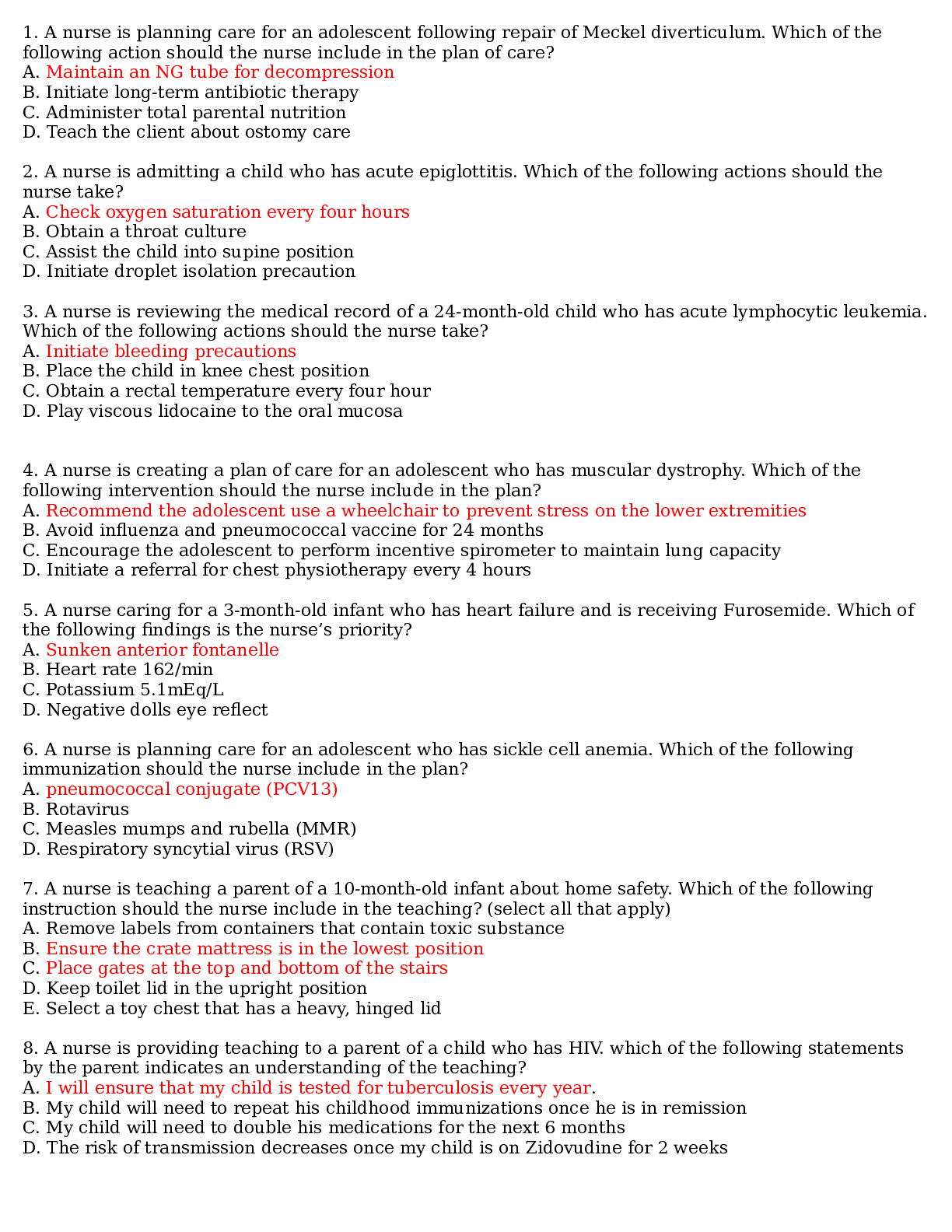
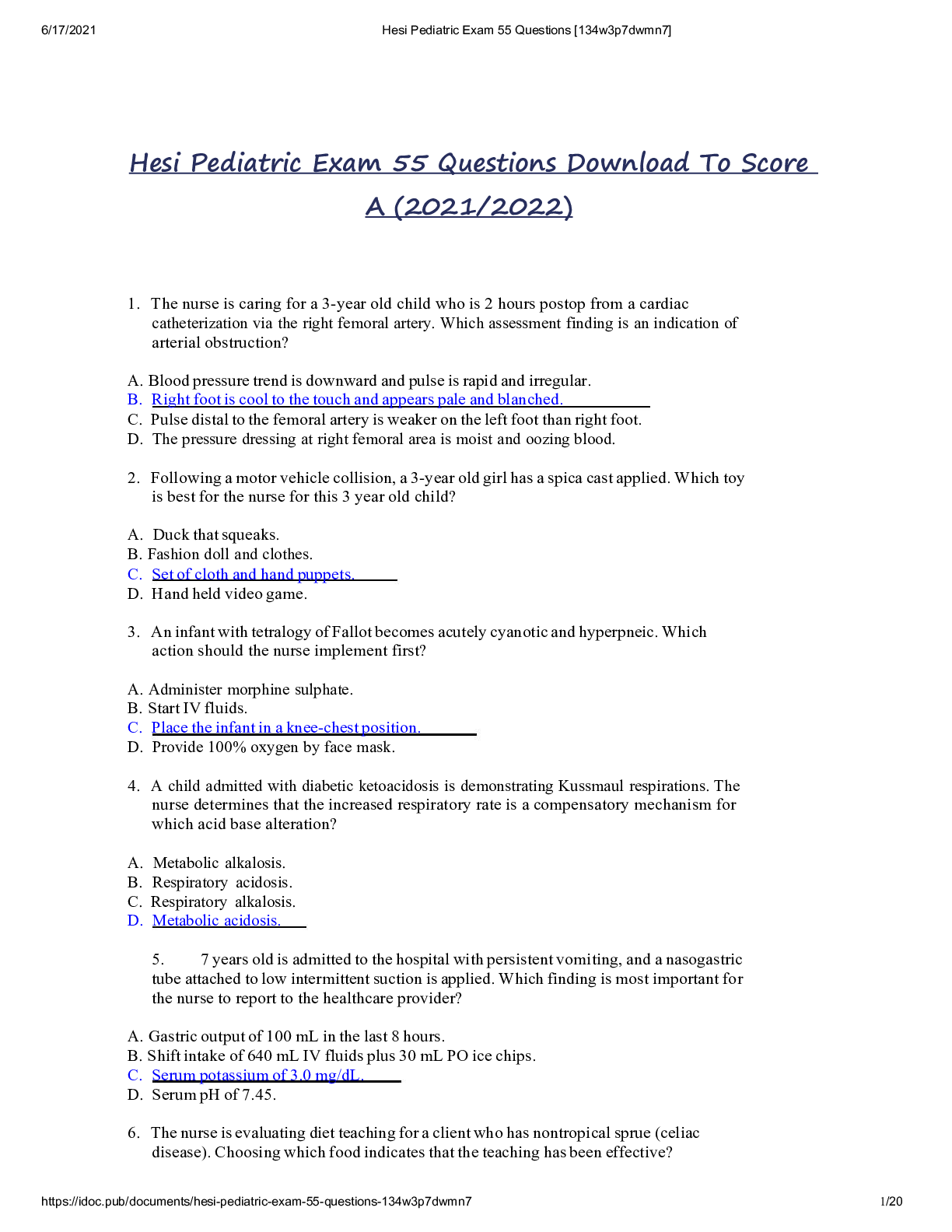
.png)
